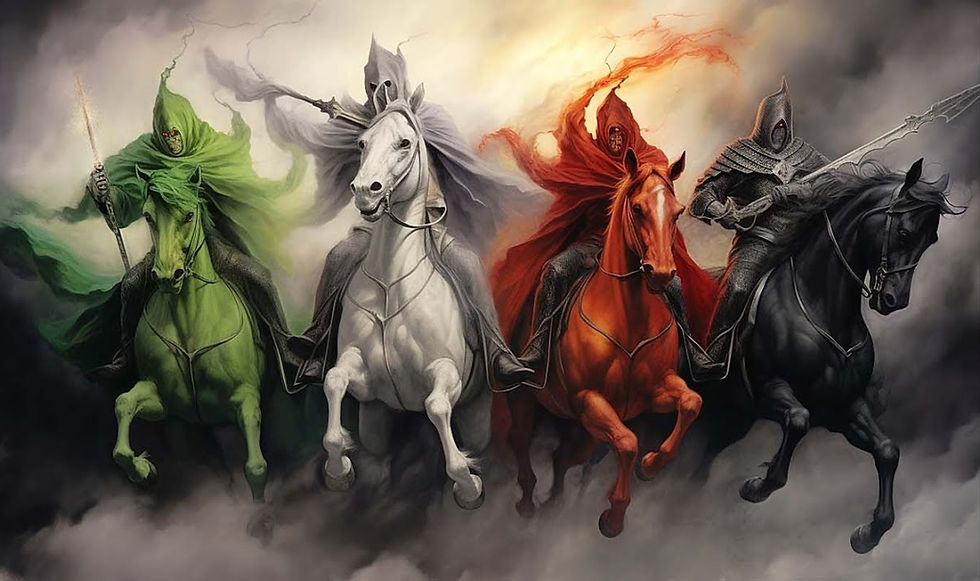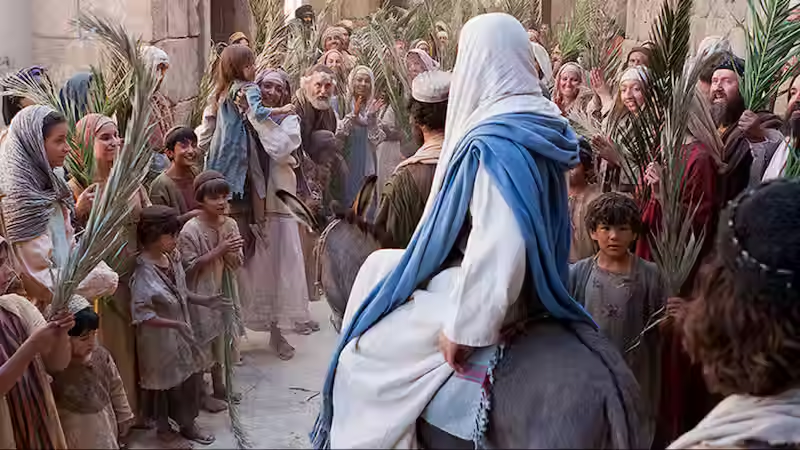The Four Horsemen of Revelation: Unraveling the Symbols and Significance of the Riders of Apocalypse
- carl1jimenez
- Jul 11
- 5 min read

The Four Horsemen of the Apocalypse are perhaps one of the most enigmatic and chilling symbols within the Book of Revelation. These riders, each distinct in color and purpose, have captivated, mystified, and alarmed readers for centuries. With powerful imagery of conquest, violence, scarcity, and death, they represent more than just eschatological events; they signify divine judgment and an impending transformation that will touch every facet of the world in the end times. But what do they symbolize, and what warnings do they hold for our generation?
The Vision of the Four Horsemen
In the Book of Revelation, chapter 6, Yahweh’s prophet Yah'chanan (John) recounts a vision where Yahshua the Messiah, described as the Lamb, opens the first of seven seals, initiating the sequence that releases the Four Horsemen upon the earth. Each seal broken is not merely an isolated event; it marks the unfolding of Yahweh’s prophetic plan, one that leads humanity toward the final reckoning. Let us examine each horseman, their role, and what their advent signifies for us today.
1. The White Horse – The Conqueror
“And I looked, and behold, a white horse. He who sat on it had a bow; and a crown was given to him, and he went out conquering and to conquer.” (Revelation 6:2)
The first rider appears on a white horse, a color often associated with purity, victory, and sometimes deception. This horseman wields a bow and is granted a crown, symbolizing conquest and authority. Unlike the triumphant nature often tied to the color white, this rider’s mission is conquest through subjugation, possibly pointing to the rise of political or religious figures who deceive under the guise of righteousness.
In the end times, this rider represents deceptive leadership, an authority that will conquer the world not through force alone, but through ideological or spiritual influence. Many scholars view this rider as a precursor to the rise of a false prophet or the “Anti-Messiah" (Antichrist) figure, someone who promises peace but ultimately brings division and deception. This rider serves as a warning to discern truth from falsehood, as it signals a world captivated by seemingly righteous but ultimately destructive leadership.
2. The Red Horse – The Sword of War
“When He opened the second seal, I heard the second living creature saying, ‘Come and see.’ Another horse, fiery red, went out. And it was granted to the one who sat on it to take peace from the earth, and that people should kill one another; and there was given to him a great sword.” (Revelation 6:3-4)
The second rider, on a red horse, carries a great sword and brings bloodshed, signifying widespread conflict and war. Red, the color of blood, represents violence and unrest, as this horseman is given power to remove peace from the earth. This period will see escalated violence, not just between nations but possibly among communities and even within households, as Yahshua forewarned in Matthew 24:6-7.
This horseman’s appearance signals the inevitable breakdown of order, a collapse in human civility and brotherhood as the world descends into chaos. As nations and societies fracture, this rider reminds us of Yahweh’s ultimate sovereignty over both peace and judgment, warning us of the consequences of unrestrained human ambition and rebellion against divine law. In the end times, this unrest can be seen as judgment on a world that has rejected Yahweh’s ways, choosing warfare and self-exaltation over humility and obedience.
3. The Black Horse – Famine and Economic Collapse
“When He opened the third seal, I heard the third living creature say, ‘Come and see.’ So I looked, and behold, a black horse, and he who sat on it had a pair of scales in his hand.” (Revelation 6:5)
The third rider emerges on a black horse, holding a pair of scales. This imagery of scales often symbolizes economic instability and scarcity. The text following his arrival warns of inflated prices for basic necessities like wheat and barley, signaling a time of severe inflation, scarcity, and famine. This rider’s impact goes beyond mere economic downturns, it signifies a global crisis where resources become scarce and access to food and basic needs is severely restricted.
This famine and inflation reflect Yahweh’s judgment on a world consumed by materialism, greed, and neglect of the vulnerable. The warning here is stark: humanity’s relentless pursuit of wealth and self-indulgence leads to a time when even the most basic provisions are beyond reach. This third horseman shows us that in the end times, no empire, economy, or storehouse will shield society from the consequences of collective selfishness and neglect of Yahweh’s provision and commands.
4. The Pale Horse – Death and Hades
“So I looked, and behold, a pale horse. And the name of him who sat on it was Death, and Hades followed with him. And power was given to them over a fourth of the earth, to kill with sword, with hunger, with death, and by the beasts of the earth.” (Revelation 6:8)
The final rider appears on a pale or ashen horse, often understood to resemble the color of a corpse, symbolizing death. This rider is named Death, and he is followed closely by Hades, the grave, representing a sweeping annihilation where life is extinguished through various means: sword, famine, pestilence, and wild beasts.
This last horseman is the culmination of the judgments that the other three riders bring upon humanity. With the power to claim a fourth of the earth’s population, this horseman reminds us that human mortality and the temporal nature of life are under Yahweh’s domain. In the end times, as Death and Hades are unleashed, they represent Yahweh’s final warning to humanity, calling us to repentance and awakening us to the reality of His ultimate control over life and death.
What the Four Horsemen Mean for Us Today
The Four Horsemen serve as a powerful warning and a call to action. Their arrival heralds a world fundamentally transformed, one gripped by deception, violence, scarcity, and mass death. Yet, for those who seek Yahweh, these judgments can be viewed not merely as punishment but as the birth pangs of Yahweh’s righteous rule, a necessary precursor to the establishment of His Kingdom on earth. In the end times, they remind us to remain vigilant, discerning, and grounded in Yahweh’s truth.
As we see signs of conflict, moral decay, economic volatility, and increasing natural and human-driven crises, these Four Horsemen compel us to reflect on our values and our priorities. Yahweh has provided us with a roadmap through these symbols, a call to righteousness amid a world descending into chaos. It is a call to look beyond worldly securities, to trust in Yahweh’s sovereignty, and to align ourselves with His will before the seals are fully opened.
In this time of great tribulation and trial, let us remember the words of Yahshua: “He who endures to the end shall be saved.” The Four Horsemen are not merely agents of destruction but symbols of transformation, a call to forsake the ways of the world and to prepare ourselves for Yahweh’s everlasting Kingdom.
By: Carlos Jimenez



Comments